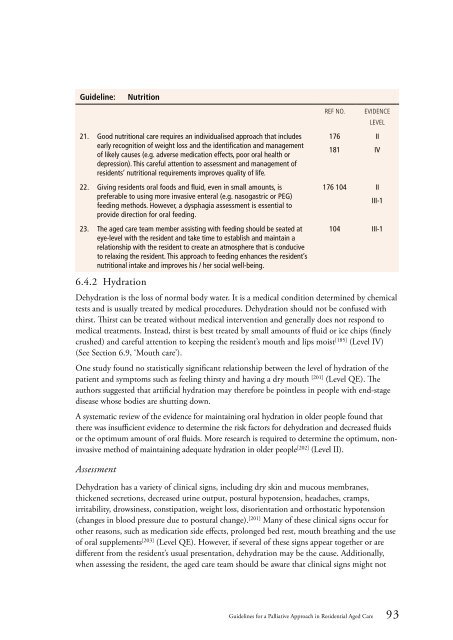Guidelines for a Palliative Approach in Residential Aged Care
Guidelines for a Palliative Approach in Residential Aged Care
Guidelines for a Palliative Approach in Residential Aged Care
You also want an ePaper? Increase the reach of your titles
YUMPU automatically turns print PDFs into web optimized ePapers that Google loves.
Guidel<strong>in</strong>e:<br />
Nutrition<br />
21. Good nutritional care requires an <strong>in</strong>dividualised approach that <strong>in</strong>cludes<br />
early recognition of weight loss and the identification and management<br />
of likely causes (e.g. adverse medication effects, poor oral health or<br />
depression). This careful attention to assessment and management of<br />
residents’ nutritional requirements improves quality of life.<br />
22. Giv<strong>in</strong>g residents oral foods and fluid, even <strong>in</strong> small amounts, is<br />
preferable to us<strong>in</strong>g more <strong>in</strong>vasive enteral (e.g. nasogastric or PEG)<br />
feed<strong>in</strong>g methods. However, a dysphagia assessment is essential to<br />
provide direction <strong>for</strong> oral feed<strong>in</strong>g.<br />
23. The aged care team member assist<strong>in</strong>g with feed<strong>in</strong>g should be seated at<br />
eye-level with the resident and take time to establish and ma<strong>in</strong>ta<strong>in</strong> a<br />
relationship with the resident to create an atmosphere that is conducive<br />
to relax<strong>in</strong>g the resident. This approach to feed<strong>in</strong>g enhances the resident’s<br />
nutritional <strong>in</strong>take and improves his / her social well-be<strong>in</strong>g.<br />
6.4.2 Hydration<br />
Ref No.<br />
176<br />
181<br />
Evidence<br />
level<br />
II<br />
IV<br />
176 104 II<br />
III-1<br />
104 III-1<br />
Dehydration is the loss of normal body water. It is a medical condition determ<strong>in</strong>ed by chemical<br />
tests and is usually treated by medical procedures. Dehydration should not be confused with<br />
thirst. Thirst can be treated without medical <strong>in</strong>tervention and generally does not respond to<br />
medical treatments. Instead, thirst is best treated by small amounts of fluid or ice chips (f<strong>in</strong>ely<br />
crushed) and careful attention to keep<strong>in</strong>g the resident’s mouth and lips moist [185] (Level IV)<br />
(See Section 6.9, ‘Mouth care’).<br />
One study found no statistically significant relationship between the level of hydration of the<br />
patient and symptoms such as feel<strong>in</strong>g thirsty and hav<strong>in</strong>g a dry mouth [201] (Level QE). The<br />
authors suggested that artificial hydration may there<strong>for</strong>e be po<strong>in</strong>tless <strong>in</strong> people with end-stage<br />
disease whose bodies are shutt<strong>in</strong>g down.<br />
A systematic review of the evidence <strong>for</strong> ma<strong>in</strong>ta<strong>in</strong><strong>in</strong>g oral hydration <strong>in</strong> older people found that<br />
there was <strong>in</strong>sufficient evidence to determ<strong>in</strong>e the risk factors <strong>for</strong> dehydration and decreased fluids<br />
or the optimum amount of oral fluids. More research is required to determ<strong>in</strong>e the optimum, non<strong>in</strong>vasive<br />
method of ma<strong>in</strong>ta<strong>in</strong><strong>in</strong>g adequate hydration <strong>in</strong> older people [202] (Level II).<br />
Assessment<br />
Dehydration has a variety of cl<strong>in</strong>ical signs, <strong>in</strong>clud<strong>in</strong>g dry sk<strong>in</strong> and mucous membranes,<br />
thickened secretions, decreased ur<strong>in</strong>e output, postural hypotension, headaches, cramps,<br />
irritability, drows<strong>in</strong>ess, constipation, weight loss, disorientation and orthostatic hypotension<br />
(changes <strong>in</strong> blood pressure due to postural change). [201] Many of these cl<strong>in</strong>ical signs occur <strong>for</strong><br />
other reasons, such as medication side effects, prolonged bed rest, mouth breath<strong>in</strong>g and the use<br />
of oral supplements [203] (Level QE). However, if several of these signs appear together or are<br />
different from the resident’s usual presentation, dehydration may be the cause. Additionally,<br />
when assess<strong>in</strong>g the resident, the aged care team should be aware that cl<strong>in</strong>ical signs might not<br />
<strong>Guidel<strong>in</strong>es</strong> <strong>for</strong> a <strong>Palliative</strong> <strong>Approach</strong> <strong>in</strong> <strong>Residential</strong> <strong>Aged</strong> <strong>Care</strong> 93
















